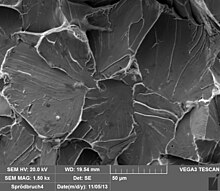Brittle fracture

light: brittle / forced fracture
dark: fatigue fracture with rest lines

In fracture mechanics, a sudden material failure is referred to as brittle fracture (also separating fracture ) . It occurs mainly with hard and brittle materials with low ductility and toughness (typical examples: glass , ceramics , ice ). Brittle materials are characterized in the stress-strain diagram by a steep rise in Hooke's straight line , at the end of which the break occurs without plastic deformation. The start of fracture occurs at microscopic material defects where mechanical stresses are concentrated. Since most metals break ductile ( deformation fracture), brittle fractures can only be found in some metals and only under certain boundary conditions (technically relevant in the context of weldability ). Pig iron and chromium , for example , generally metals with body-centered cubic and hexagonal crystal lattices, tend to brittle fracture . Brittle fractures can, however, also occur in metals that are ductile below room temperature if they show a significant decrease in notched impact strength at low temperatures . In addition to the influence of temperature, the literature also mentions the presence of multiaxial stress as a favorable factor. Brittle fractures occur intercrystalline or transcrystalline , deformation fractures transcrystalline (ie the crack goes through the grains of the structure), residual force fractures on components under dynamic load can either be deformation fractures or brittle fractures.
See also
- Break separation - manufacturing process that separates components by means of a brittle break
Individual evidence
- ↑ Dieter Radaj: Fatigue strength ; 3rd edition, Springer Verlag, page 235, ISBN 978-3-540-71458-3 .
- ^ Bargel, Schulze: Material Science ; 9th edition, Springer Verlag, page 83, ISBN 3-540-26107-9 .
- ^ Bargel, Hans-Jürgen., Schulze, Günter .: Material science . 11., arr. Edition 2012. Springer, Berlin 2012, ISBN 978-3-642-17716-3 , pp. 149 .
- ↑ Dieter Radaj: Fatigue strength ; 3rd edition, Springer Verlag, page 141, ISBN 978-3-540-71458-3 .
- ^ Erwin Haibach: operational stability ; 3rd edition, Springer Verlag, page 438, ISBN 3-540-29363-9 .